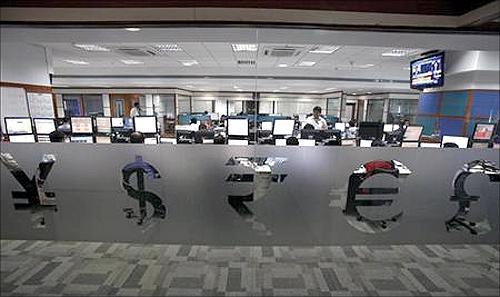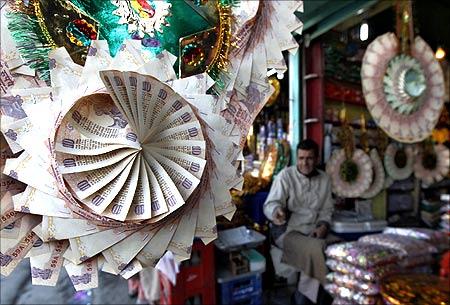BankBazaar.com
The Rupee plunged to a record low of Rs 59 on Monday sending panic waves across investors, bankers and raising serious concerns in the finance ministry.
Investors are worried as it will cut down the returns of foreign institutional investors (FIIs). This in turn will hit the stock market negatively.
Bankers are concerned that the steep drop in the value of rupee may delay Reserve Bank’s rate cuts further halting the dream run banks experienced in last couple of months.
The government is under pressure as the fall of the Rupee will further increase the country’s deficit. However, the worst hit, due to this crash of the rupee, would be students who are planning to pursue further education abroad.
The students will have to chip in a lot more money from the family’s hard earned savings to study abroad and many may even drop the plans of studying abroad.
…
How Rupee fall impacts education abroad
Image: A girl looks at a book stall in Lucknow.Photographs: Pawan Kumar/Reuters
The lure of foreign education
Foreign education is dream for many Indian students. The exposure to high intellectual standards, competitive environment, and meritocracy are the factors that drive our youngsters to American or European shores for higher education.
However, they face financial problems. In recent times, the government has directed banks to be more liberal in granting education loans.
Even though the loan rates are still higher, there are better chances of getting loans for education abroad.
…
How Rupee fall impacts education abroad
Image: Foreign currency traders work inside a trading firm behind the signs of various world currencies, in Mumbai.Photographs: Vivek Prakash/Reuters
Impact of depreciation of rupee
When students go abroad for education (let’s take the United States), they pay fees and incur expenses in dollars. When rupee goes down, the amount needed to pay in dollars rises. Hence, rupee depreciation increases your funding requirement.
Let’s look at it this way.
The typical cost of studying in US universities is anywhere between $15,000 and $30,000 per year. This is just the fee.
The living expenses are about $15000 in a year. Hence, a student has to invest about $30,000 to $50,000 per year for higher education, which is a huge burden.
The total course would cost anywhere between $40,000 and $80,000.
Now suppose a student, named Indranil, plans to study in an US university and takes a loan from banks. He estimates that it will require $40,000 for his entire education when the exchange rate is Rs 50 per USD.
…
How Rupee fall impacts education abroad
Image: A bank employee counts one hundred dollar notes at a bank in Seoul.Photographs: Lee Jae Won/Reuters
Hence, he applies for an education loan of Rs 20 lakh. However, by the time, he is about to pay the fee and go to the United States, the exchange rate changes to Rs 55 per USD. This means, the cost of education is up by 10 per cent.
Indranil now will have to pay Rs 22 lakh. So his expenses will go up by Rs 2 lakh.
Many parents fund their children’s education from their savings. Any depreciation in rupee adds to their woes as they have to shell out more money.
The only set of students who will gain from rupee depreciation are those who have already completed their studies and are going to repay their loan. For them, depreciation of rupee means fewer dollars to be paid back to the bank.
…
How Rupee fall impacts education abroad
Image: An employee arranges Indian currency notes at a cash counter inside a bank in New Delhi.Photographs: Mukesh Gupta/Reuters
How to manage the crisis
The first option is to speak with the bank and ask for further loans. Banks have introduced top-up schemes for education loan where they fill the gap created by the exchange rate fluctuation.
Hence in our example, Indranil can get top-up of Rs 2 lakh from the same bank.
This will certainly increase the payback amount but it will help students continue with their studies.
The other option is to wait and watch RBI’s action on the exchange rate. Typically, RBI intervenes when the exchange rate goes closer to Rs 60 per USD.
This option is fraught with risks. Every rupee slide has reasons behind it. Sometimes, the reasons are manageable and hence RBI takes action to restore rupee at a certain level. Sometimes, there are structural reasons for the slide. In such cases, even RBI may not have much say.
…
How Rupee fall impacts education abroad
Image: A Kashmiri shopkeeper sits near garlands made of Indian currency notes at a market in SrinagarPhotographs: Fayaz Kabli/Reuters
Conclusion
There have been different voices from the market projecting opposite actions. Some say that rupee may touch 60 and go beyond.
In fact, some experts have said that the fall may even touch Rs 70 as this seems to be the right exchange rate given the higher inflation India has been going through for last couple of quarters.
On the other hand, the Reserve Bank and Finance Ministry have sounded optimistic that the fall can be arrested.







article